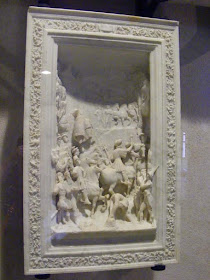Gaston de Foix, Duc de Nemours, was only 22 when he was killed at the Battle of Ravenna. His military career was short but by all accounts brilliant. By early 1512 he controlled northern Italy, on behalf of his uncle Louis XII, who had fallen out with the Pope Julius II and the Holy Roman Emperor Maximilian I and was engaged in staking his claim to Milan and the surrounding area on the basis of his Visconti grandmother.
The exquisite detail achieved by Bambaia and his sensitive modelling of the handsome young man was universally admired.
The death of de Foix was a great blow to French ambitions in the area. He was young, energetic, hot-headed and brave and had been shot and killed leading a cavalry charge against the Spanish infantry. Both his contemporaries and modern historians hint that the final outcome of the Italian Wars could have been very different had he lived.
Gaining the nickname le la Foudre d'Italie ('the Thunderbolt of Italy') Gaston showed a talent for manoeuvering and strategy that many compare with Napoleon. He specialised in rapid cross country marches and audacious offensive actions.
Check out the trendy goatee...
His body was placed in the Duomo in Milan, surrounded by captured weapons and pennants, but after the French left the city his remains were moved to another church, now demolished. In 1515 when François I retook Milan he ordered a funerary monument fit for such a warrior, but once the city reverted to the Sforza's the work was abandoned. Today most of the completed elements are displayed in the Castello Sforzesco. The sculptor is Agostino Busti, known as Bambaia and the work is considered to be his masterpiece.
Two of the panels showing de Foix's military engagements intended for the base of the tomb, carved in a mixture of high and low relief typical of late medieval Milanese work.








6 comments:
An interesting point of grammar showing the importance of gender in French. There are many homographs in the language meaning different things whether they are feminine or masculine. The case in point here is foudre. Lightning is LA foudre, whereas LE foudre would be a tun, something that is probably used by wineries in the Loire Valley, but cannot apply figuratively to this slim young man. LOL
Coup de foudre, (thunderbolt), would be when you fall madly in love at first sight.
In this sculpture, the face is youthful and serene, but the rest is very stiff, as if his clothing was made of cardboard.
LOL. In that case whoever wrote the French wikipedia entry has made a grammatical error. Mind you, I didn't pick up on it at all. I think 'the Thunderbolt of Italy' is a reasonable translation. It may not be quite literal, but gives a good sense of the meaning.
I do agree with you. It shows that Wikipedia is unreliable, whether for actual facts or grammar correctness. I just checked the French Wikipedia page for Gaston de Foix and found another grammatical error. However, the fact that Foudre d'Italie is in italics makes the le just a little less of an error [lol].
Wikipedia articles are written by volunteers (bénévoles) who get their information on the Net where mistakes are swarming. Just like the Wikipedia page about my grandfather written by a volunteer that is full of errors. I tried to correct them but Wikipedia didn't let me do it! So I gave up.
I noticed that amongst the 19th C literature online he is about 50:50 'le foudre' and 'la foudre'.
The creases in his leggings lend a human touch which counteracts the rigidity of the folds in his clothing. What a handsome young fellow!
I think he's wearing armour, with poleyns (knee protectors).
Post a Comment